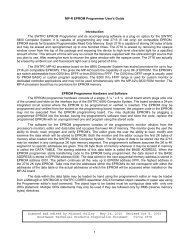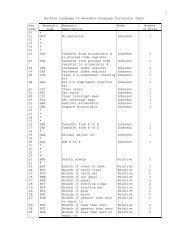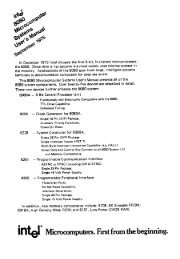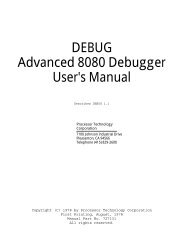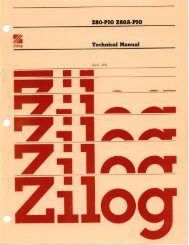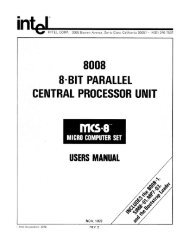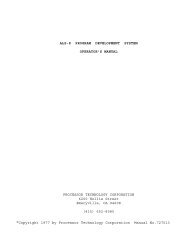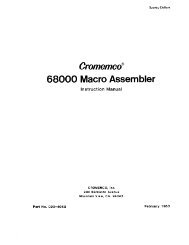The System Manual of SOL-20 - History of Computers
The System Manual of SOL-20 - History of Computers
The System Manual of SOL-20 - History of Computers
Create successful ePaper yourself
Turn your PDF publications into a flip-book with our unique Google optimized e-Paper software.
IV.<br />
SET COMMANDS (cont.)<br />
Set Type Command<br />
SET TYPE data<br />
This command sets (data) values into the 'type' byte in the tape<br />
header information when used in conjunction with the SAVE command.<br />
<strong>The</strong> 'type' byte data is entered as a hexadecimal value, but it will<br />
appear on the screen as an ASCII character when displayed by the<br />
GET or CAT command. Only displayable characters should be used for<br />
type values (data). <strong>The</strong> most significant bit <strong>of</strong> the type value<br />
determines if the tape file can be executed automatically by an XEQ<br />
command. (0 = Auto-execute, 1 = Not executable.) Typing <strong>of</strong> tape<br />
files can be very useful in grouping common files.<br />
Example: SET TYPE 47<br />
47 = 'G' character for GAME FILES<br />
Sign Bit = 0, auto-execute<br />
SET TYPE 50<br />
50 = 'P' character for PROGRAM FILES<br />
Sign Bit = 0, auto-execute<br />
SET TYPE C4<br />
C4 = 'D' character for DATA FILES<br />
Sign Bit = 1, non-execute<br />
Set Execute Command<br />
SET XEQ addr<br />
This command sets the auto-execute address (addr) word into the<br />
tape header information when used in conjunction with the SAVE<br />
command. This address word is used by the XEQ command after loading<br />
a tape file to begin program execution at location specified<br />
by tape header information (addr). Note that the 'TYPE' byte<br />
determines if the file is <strong>of</strong> the auto-execute type.<br />
Example: SET XEQ <strong>20</strong>0<br />
Result:<br />
<strong>The</strong> auto-execute address <strong>of</strong> <strong>20</strong>0 Hex will be written<br />
onto the tape header when the next SAVE command is<br />
issued.<br />
Custom Input/Output Commands<br />
<strong>The</strong> next SET commands set address pointers to custom input and output<br />
driver routines when 'SET I=3' and/or 'SET O=3' are used. <strong>The</strong>se<br />
custom I/O drivers must meet the <strong>SOL</strong>OS I/O drivers requirements.<br />
See the <strong>SOL</strong>OS s<strong>of</strong>tware listing for model input routine.<br />
Set Custom Output Command<br />
SET COUT addr<br />
This command informs <strong>SOL</strong>OS s<strong>of</strong>tware where the user defined output<br />
routine specified by 'addr' is located.<br />
11



